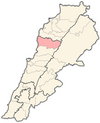Ras Osta
Ras Osta راس اسطا Ras Usta | |
|---|---|
 Ras Osta Location in Lebanon | |
| Coordinates: 34°6′54″N 35°43′24″E / 34.11500°N 35.72333°E / 34.11500; 35.72333Coordinates: 34°6′54″N 35°43′24″E / 34.11500°N 35.72333°E / 34.11500; 35.72333 | |
| Country | Lebanon |
| Governorate | Mount Lebanon |
| District | Jbeil |
| Area | |
| • Total | 429 ha (1,060 acres) |
| Elevation | 900 m (3,000 ft) |
Ras Osta (Arabic: راس اسطا, also spelled Ras Usta) is a municipality in the Jbeil District of Mount Lebanon Governorate, Lebanon. It is 55 kilometers north of Beirut. Ras Osta has an average elevation of 900 meters above sea level and a total land area of 429 hectares. There were two companies with more than five employees operating in the village as of 2008.[1] Its inhabitants are predominantly Shia Muslims.[2]
References
^ "Ras Osta". Localiban. Localiban. 18 January 2008. Retrieved 12 February 2016..mw-parser-output cite.citation{font-style:inherit}.mw-parser-output .citation q{quotes:"""""""'""'"}.mw-parser-output .citation .cs1-lock-free a{background:url("//upload.wikimedia.org/wikipedia/commons/thumb/6/65/Lock-green.svg/9px-Lock-green.svg.png")no-repeat;background-position:right .1em center}.mw-parser-output .citation .cs1-lock-limited a,.mw-parser-output .citation .cs1-lock-registration a{background:url("//upload.wikimedia.org/wikipedia/commons/thumb/d/d6/Lock-gray-alt-2.svg/9px-Lock-gray-alt-2.svg.png")no-repeat;background-position:right .1em center}.mw-parser-output .citation .cs1-lock-subscription a{background:url("//upload.wikimedia.org/wikipedia/commons/thumb/a/aa/Lock-red-alt-2.svg/9px-Lock-red-alt-2.svg.png")no-repeat;background-position:right .1em center}.mw-parser-output .cs1-subscription,.mw-parser-output .cs1-registration{color:#555}.mw-parser-output .cs1-subscription span,.mw-parser-output .cs1-registration span{border-bottom:1px dotted;cursor:help}.mw-parser-output .cs1-ws-icon a{background:url("//upload.wikimedia.org/wikipedia/commons/thumb/4/4c/Wikisource-logo.svg/12px-Wikisource-logo.svg.png")no-repeat;background-position:right .1em center}.mw-parser-output code.cs1-code{color:inherit;background:inherit;border:inherit;padding:inherit}.mw-parser-output .cs1-hidden-error{display:none;font-size:100%}.mw-parser-output .cs1-visible-error{font-size:100%}.mw-parser-output .cs1-maint{display:none;color:#33aa33;margin-left:0.3em}.mw-parser-output .cs1-subscription,.mw-parser-output .cs1-registration,.mw-parser-output .cs1-format{font-size:95%}.mw-parser-output .cs1-kern-left,.mw-parser-output .cs1-kern-wl-left{padding-left:0.2em}.mw-parser-output .cs1-kern-right,.mw-parser-output .cs1-kern-wl-right{padding-right:0.2em}
^ Cammett, Melani; Issar, Sukriti (July 2010). "Bricks and Mortar Clientalism: Sectarianism and the Logics of Welfare Allocation in Lebanon". National Center for Biotechnology Information, U.S. National Library of Medicine. doi:10.1353/wp.0.0056. PMC 4029429. Missing or empty|url=(help)
This Lebanon location article is a stub. You can help Wikipedia by expanding it. |
